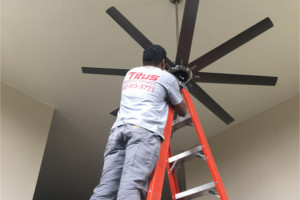Effective Tips for Faulty Ceiling Fans

Ceiling fans are an excellent way to keep your home cool and comfortable, especially during the hot summer months. However, like any other electrical appliance, ceiling fans can develop faults and stop working altogether. If your ceiling fan has stopped spinning, it can be frustrating, especially if you don't know how to fix it. In this blog post, we'll be discussing effective tips to fix a faulty ceiling fan, so you can get back to enjoying the comfort it provides.
Why my ceiling fan does not spin?
There can be various reasons why your ceiling fan has stopped spinning. The most common reasons include power connection issues, blown capacitor, faulty bearings, and a faulty flywheel.
Look for power connection:
The first thing to do when your ceiling fan stops working is to check the power connection. Ensure that the fan is plugged in correctly and that the circuit breaker hasn't tripped. If the power connection is good, but the fan still isn't working, check the capacitor.
Look for blown capacitor:
If the capacitor is blown, the ceiling fan won't work, and you'll need to replace it. The capacitor is a small cylindrical object that helps the motor start and run. You can test the capacitor using a multimeter to determine if it's faulty or not.
Check the bearings:
If the power connection and capacitor are both in good condition, check the bearings. Bearings help the fan blades rotate smoothly, and if they are worn or damaged, the fan won't spin. Lubricating the bearings or replacing them can solve the problem.
Check the faulty flywheel:
Another common issue that can cause your ceiling fan to stop spinning is a faulty flywheel. The flywheel is responsible for moving the fan blades, and if it's broken or damaged, the blades won't turn. Replacing the flywheel can help solve this issue.
Make your ceiling fan energy efficient:
While fixing your ceiling fan, you can also take steps to make it more energy-efficient. Switch to LED light bulbs, as they consume less energy, and install a ceiling fan with a high Energy Star rating.
Conclusion:
In conclusion, a faulty ceiling fan can be a frustrating problem, but with the right tips and knowledge, you can fix it easily. Checking the power connection, capacitor, bearings, and flywheel are some of the common steps to diagnose the issue. And while you're at it, don't forget to make your ceiling fan more energy-efficient. If you're still having issues with your ceiling fan, it's best to contact a local licensed electrician in Fort Collins to help you diagnose and fix the issue. Contact Titus Electrical Services today for reliable and affordable electrical services for your home or office.
